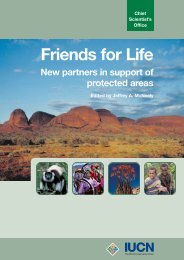Guidelines for Planning and Managing Mountain Protected Areas
Guidelines for Planning and Managing Mountain Protected Areas
Guidelines for Planning and Managing Mountain Protected Areas
- No tags were found...
You also want an ePaper? Increase the reach of your titles
YUMPU automatically turns print PDFs into web optimized ePapers that Google loves.
III. Preservation of mountain biodiversity <strong>and</strong> physiographic features13. L<strong>and</strong> use (cultivation, grazing, plant harvesting, hunting, fishing) within protectedl<strong>and</strong>scapes (Category V) or Resource Management <strong>Areas</strong> (Category VI) <strong>and</strong> specifieduse zones of other protected areas should be regulated to ensure that viable <strong>and</strong> functionalpopulations of wild plants <strong>and</strong> animals are maintained. Monitoring programmes shouldassess the impact of such activities.14. Conservation of agrobiodiversity, including “heritage” breeds, should be encouragedamong local within-PA or neighbouring l<strong>and</strong> users. Outside the MtPA boundaries,private or communal stewardship l<strong>and</strong>s can provide both wild native-biodiversity buffers<strong>and</strong> domesticated valued biodiversity.Research <strong>and</strong> education/interpretation15. International, national <strong>and</strong> local databanks should be analysed in order to identify rare<strong>and</strong> endangered species, endemics <strong>and</strong> geoheritage types <strong>and</strong> should include biological,physical <strong>and</strong> ecological inventories.16. Research in mountain PAs should target threats <strong>and</strong> management needs, includingcollection of in<strong>for</strong>mation on the ecology of species that have a key role in the structure<strong>and</strong> function of ecosystems (“keystone” species) <strong>and</strong> “umbrella” species. Data should becollected <strong>and</strong> managed to facilitate decision-making, such as planning <strong>and</strong> monitoring.17. Research on physiographic features, geology, palaeoecology <strong>and</strong> glaciers provides usefulin<strong>for</strong>mation on the history <strong>and</strong> functions of the areas <strong>and</strong> can provide input to management<strong>and</strong> educational activities.18. Research on biodiversity <strong>and</strong> the history, ecology <strong>and</strong> cultural attractions of the PAshould feed into educational, interpretation <strong>and</strong> outreach programmes.19. Research should also be focused on aquatic biodiversity <strong>and</strong> watershed function.20. All- taxa biodiversity surveys can be triggered by “biodiversity blitzes”, assemblingteams of specialist scientists from other agencies or universities, as has been done in GreatSmoky <strong>Mountain</strong>s NP <strong>and</strong> The Australian Alps NPs.21. Creative use of local, minimally trained para-taxonomists is encouraged, such as has beenso effective in Costa Rica’s INBIO programme.22. Educational programmes should be developed to in<strong>for</strong>m local people, the general population<strong>and</strong> decision-makers of the area’s importance <strong>for</strong> biodiversity, watershed protection<strong>and</strong> other ecosystem services. Details of park management, research <strong>and</strong> conservationneeds should be communicated to local stakeholders, with an explicit emphasis on thelinks between the PA’s biodiversity <strong>and</strong> local development <strong>and</strong> culture. Visitor <strong>and</strong>interpretation centres can provide an effective focus.17






